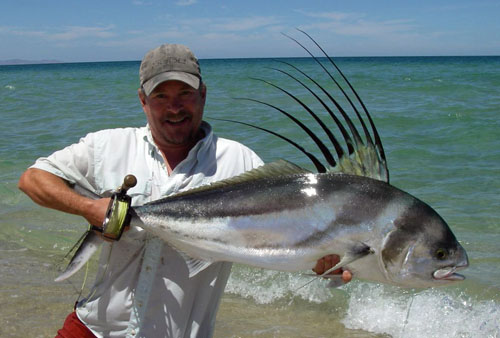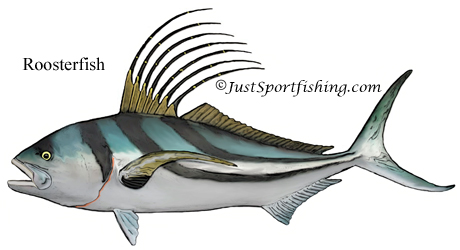
Nematistius pectoralis
FAMILY
Nematistiidae
TAXONOMY
Nematistius pectoralis Gill, 1862, Cape Saint Lucas, Baja California,
Mexico.
OTHER COMMON NAMES
None known.
PHYSICAL CHARACTERISTICS
Body fusiform and elongate, with a raised profile of the head
that extends to the dorsal fin. The first dorsal fin has seven
long spines that retract into a groove; it may have a signal
function, or it may be used in maneuvering when attacking
prey. A second dorsal fin has 25–28 soft rays. There are three
spines and 15–17 soft rays in the anal fin. The caudal fin is
forked. Body color is blue dorsally and silvery white ventrally.
There are black stripes positioned obliquely on the dorsal surface;
one runs up onto the upper lobe of the caudal fin. Grows
to nearly 65 in (165 cm) in length, with a weight of nearly 115
lb (52 kg).
DISTRIBUTION
Eastern Pacific from southern California, where it is rare,
south through Baja California, Mexico, and the Gulf of California,
where it is more common, and down to Peru and west
to the Galбpagos Islands.
HABITAT
Mainly inshore or near-coastal habitats, especially off sandy
beaches.
BEHAVIOR
Not well known. Usually solitary or travels in small groups.
FEEDING ECOLOGY AND DIET
A predator upon fishes and other smaller pelagic organisms.
REPRODUCTIVE BIOLOGY
Reproduction not well known. Likely a pelagic spawner, with
pelagic eggs and larvae. May spawn in groups. Spawning probably
is seasonal, especially at higher latitudes.
CONSERVATION STATUS
Not listed by the IUCN, but vulnerable to overfishing.
SIGNIFICANCE TO HUMANS
An important game fish that also is taken as a commercial and
subsistence food fish. Some collected incidentally for public
aquaria.
Photo Gallery of - Roosterfish





 Animalia Life
Animalia Life